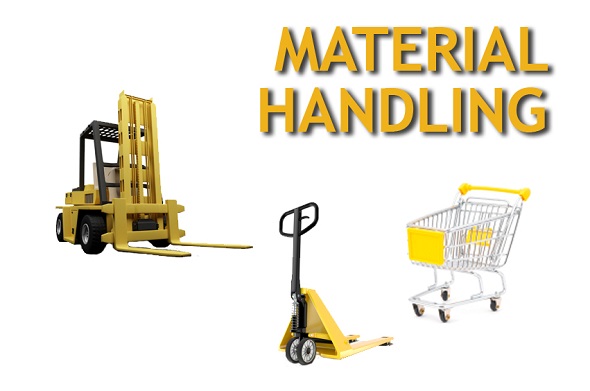The best materials handling solutions involve the least amount of handling possible. The poor principles of materials handling will add to the cost but not to the value of the product.
The choice of the right equipment or system to optimize material flow is broadly a definition of MATERIAL HANDLING and includes cranes, conveyors, automated vehicles, tractors, free-ranging forklifts, order pickers, stackers, and pallet trucks.
Let’s take a look at the basic principles of materials handling and how they might help your business save money.

The Unit Load
Products, whether they can be cartons, bags, cans bottles, drums or sacks are assembled together to form a load.
The commonly used base on which unit loads are formed are flat wooden (sometimes plastic) pallets, ISO Containers, roll cages and tote bins. Others are stillages, box and cage pallets, and bulk containers, for example.
Pallet Handling
Products are often handled without pallets using specialised attachments in place of forks: Bales, white foods, cookers, carpets, tyres, drums, beer kegs, paper rolls and milk crates are just some of the many products where attachments are utilised.
The Application
It is essential to consider all aspects of an application in order to ensure that the most suitable equipment is specified and the best handling solution selected, Important factors are :
The load and the Pallet of other load base type
a) Pallet details
Length, width, depth; type ie any baseboards; pallet underhang under forks; are the base boards chamfered? two or four-way access?
b) Load details
Weight; length when stacked on a pallet; width when stacked on a pallet; overall height of load and pallet; type of load; cartons, bags, sacks e.t.c; is the load shrink-wrapped?
Type of storage
Block stack, fixed racking, mobile racking and so on.
Stack Height
What is the maximum top shelf height onto which loads must be lifted? This will determine the height of the lift and define nominal and residual capacities.
The forks have to lift the pallet above the top shelf with sufficient clearance to place the load on the top shelf (mast defections must also be taken into account).
Overhead Obstructions
Is there sufficient clear headroom over the stacking area with the mast fully raised?
Note any overhead obstructions either in the aisle or on the travelling route. This will determine whether free lift or triplex masts are necessary.
Allow for possible future changes to the application.
Distances
To determine whether pedestrian or rider equipment is required the average and maximum distances covered in a typical work cycle need to be established. Sometimes a tractor/trailer system may be the preferable method.
Surfaces/gradients
The Length of any gradient is important as well as its surface and slope. This determines the truck and battery capacity and sometimes, the type of wheel/tyre equipment. It is also very pertinent to record the types of surfaces on the level areas.
Working area and duty
Inside or outside, order picking, lorry loading/unloading, loading docks, container stuffing, public roads.
Careful study and definition are needed.
Environment
Operating in a cold store? Ambient temperature? Abrasive /Dusty atmosphere? Hazardous material? Brine or salty conditions? Chemicals?
Other Factors
Hours per shift and number of shifts
Numbers of pallets in and pallets out per shift
Any Peak periods? If so when.
Electricity supply, ie. Single phase, three phases.
Delivery Access: ground level/loading dock.
How Many loading docks
These are all points of basic materials handling principles. If you get them right, you can save you business money on the cost of good sold.


Leave a Reply